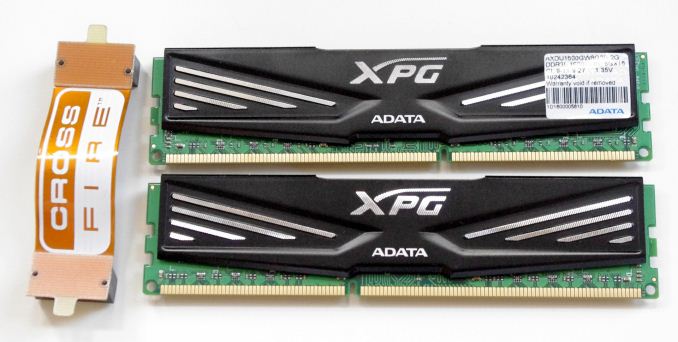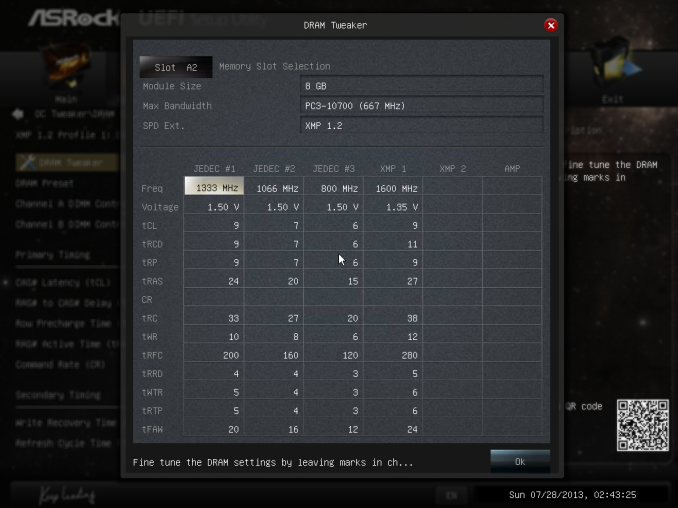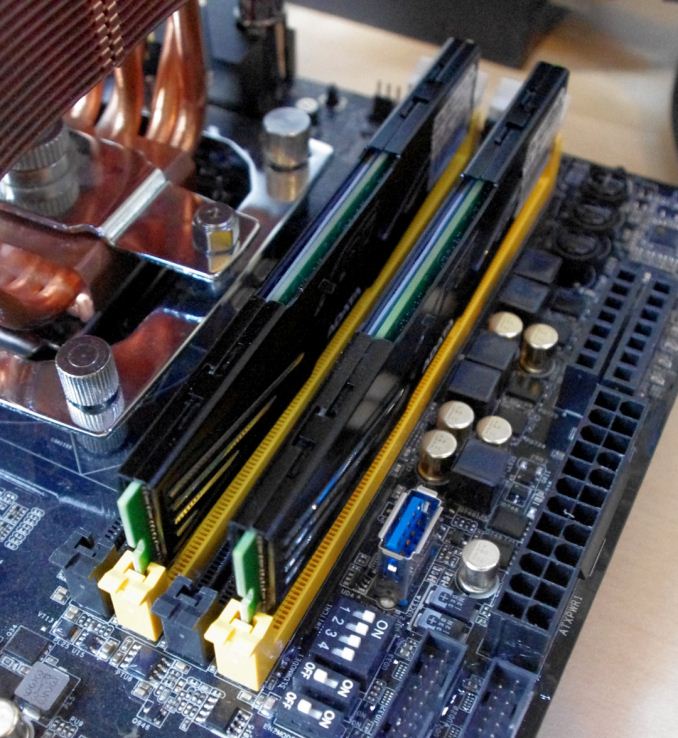ADATA XPG V1.0 Low Voltage Review: 2x8 GB at DDR3L-1600 9-11-9 1.35 V
by Ian Cutress on December 6, 2013 2:00 PM EST
For the next in our series of memory reviews on Haswell, we have another ADATA kit to test: this time a low voltage 2x8 GB kit featuring DDR3-1600 C9 timings. Being lower down the chain on a SKU list, the heatsinks are also smaller than the ones previously tested, and come in at £125. Previously in our big roundup of Haswell testing we suggested 1866 C9 being the minimum people should consider: would going 1600 C9 LV matter that much in results?
ADATA XPG V1.0 2x8GB DDR3L-1600 C9 1.35V Overview
ADATA’s line away from the more extreme (2400+) memory setups is aimed more conservative. If they were to use the same DRAM chips on board, those 2400 MHz C10 kits might hit lower voltages or lower CL numbers when we move down to 1600 MHz, so there is some potential in diversifying the product line of the same ICs as long as the market is there.
The AXDU1600GW8G9B-2G kit we are testing today is very unassuming next to those higher end modules – a simple small metallic based heatsink. When using a large air cooler like my TRUE Copper, they were easy enough to fit in unlike some of the larger modules.
The lower voltage element of memory intrigues me, most likely for the wrong reasons. The difference between 1.50 volt and 1.35 volt memory, in an overall system build, is not going to affect power draw in a measurable way. If you were building a 42U rack of servers, then yes, multiply out the DRAM modules you need across all the sockets and it can make sense if they are going to be active all the time. But at this juncture, even when a system draws sub 30W on idle and under 100W load, I cannot see a picture where moving from 1.50V to 1.35V makes a sizeable difference to a yearly electricity bill. Others may argue this point, but finding consistent data that converts to a decent power saving is hard to produce or come by. It would be more applicable to buy a lower TDP CPU (such as the i7-4765T, or E3-1230L V3) instead. That leaves a bit of e-peen for being low powered and green as positives, and the kit obviously has to stand on its own two feet when we push through the benchmarks.
In our big memory round-up for Z87 and Haswell, our cautionary tale was that slower MHz (under 1866) kits, rather than being restrictive, have a few holes in their performance on certain benchmarks, causing a 10-20% performance drop compared to the asymptotic limit hit when you go beyond 2133-2400 MHz. This ADATA 1600 C9 Low Voltage kit hits a couple of pot holes in that regard: WinRAR could be faster, as well as some of the minimum frame rates on a few games.
For Overclocking, our kit comes out of the bag with a Performance Index (PI) of 178: we pushed this to a PI of 200 (2000 10-12-10) with very little effort. This is a bit different from the PI of 240-260 which we see on the higher end kits.
Price wise, 2x8 GB 1600 C9 memory kits can be found for under $150 – the cheapest on Newegg today is actually a 1.35V kit for $129, followed by a 1.65V kit for $130. ADATA do not list this kit on Newegg, but in the UK the pricing is around £125 – if you take off our 20% tax and do the conversion, that lists it as nearer $170. ADATA’s XPG V2 and V1 normal voltage kits are at $165, with another at $150. This is still above some of their competition, and around $150 would make it a competitive choice for this segment.
Specifications
| ADATA | ADATA | Corsair | Patriot | ADATA | G.Skill | |
| Speed | 1600 | 2400 | 2400 | 2400 | 2800 | 3000 |
| ST | 9-11-9-27 | 11-13-13-35 | 10-12-12-31 | 10-12-12-31 | 12-14-14-36 | 12-14-14-35 |
|
Price (at review) |
£125 | $200 | - | $92 | $316 | $520 |
| XMP | Yes | Yes | Yes | Yes | Yes | Yes |
| Size | 2 x 8GB | 2 x 8GB | 2 x 8GB | 2 x 4GB | 2 x 8GB | 2 x 4GB |
|
Performance Index |
178 | 218 | 240 | 240 | 233 | 250 |
|
|
||||||
| MHz | 1600 | 2400 | 2400 | 2400 | 2800 | 3000 |
| Voltage | 1.35 V | 1.65 V | 1.65 V | 1.65 V | 1.65 V | 1.65 V |
| tCL | 9 | 11 | 10 | 10 | 12 | 12 |
| tRD | 11 | 13 | 12 | 12 | 14 | 14 |
| tRP | 9 | 13 | 12 | 12 | 14 | 14 |
| tRAS | 27 | 35 | 31 | 31 | 36 | 31 |
| tRC | 38 | 46 | 43 | 49 | ||
| tWR | 12 | 20 | 16 | 16 | ||
| tRRD | 280 | 315 | 301 | 391 | ||
| tRFC | 5 | 6 | 7 | 7 | ||
| tWTR | 6 | 10 | 10 | 12 | ||
| tRTP | 6 | 10 | 10 | 12 | ||
| tFAW | 24 | 33 | 26 | 29 | ||
| CR | - | 2 | 3 | 2 | ||
As you can imagine, this being our 1600 C9 kit for testing, the sub-timings are smaller than all the other kits we have tested. With a PI of 178 out of the box, there should hopefully be some room to grow.
Visual Inspection
Thankfully ADATA have avoided using annoying plastic packaging that can be a pain to get into – there is a simple tab on the back to help open their XPG line of memory. The packaging is simple enough, just a thin molded plastic to hold the memory in place. Out the memory modules come, barely taller than memory without heatsinks.
There is a slight z-height addition, but it should not affect many (if any) builds:



















35 Comments
View All Comments
Khenglish - Friday, December 6, 2013 - link
They do. It just costs more. Tons of 1600 9-9-9 T1 1.35V 8GB sticks on newegg. Even 1866 10-10-10 T1 8GB sticks.The question is if your laptop supports 1.35V or not. Only 8 series and a few 7 series laptops will run at 1.35V. Other laptops will run the memory at 1.5V despite it being 1.35V, which is fun if your laptop allows overclocking (which unfortunately is just top end clevo and alienware), but a waste of money and power if not.
jeffbui - Saturday, December 7, 2013 - link
Apple uses DDR3L in their Macbook Pros and LPDDR3 in their Air lineXpl1c1t - Friday, December 6, 2013 - link
Fail to see why this is something worth reviewing. Maybe in the 2009/2010 timeframe this would have been more relevant, but there were better performing kits available then @ 1.35v. Namely there were the GSkill ECO and Mushkin 996825 kits which were killer. I still run mine at 1700mhz 6-8-6-24-1T and 1.4v and am sure they could run well below 1.35v @ 1600.StrangerGuy - Saturday, December 7, 2013 - link
The more pressing question is the TOTAL lack of power consumption tests especially for standby states. C'mon who do you think the target customers are for low voltage RAM?MrSpadge - Sunday, December 8, 2013 - link
Those were probably 4 GB, or maybe even 2 GB modules.jeffrey - Saturday, December 7, 2013 - link
Ian Cutress,Hello! You keep writing articles about 1866/C9 being the minimum and to avoid 1600. Even going so far as to say, "Any kit 1600 MHz or less is usually bad news."
However, this ignores 1600/C8 modules. The 1600/C8 score a 200 on your Performance Index at stock timings. This is at your recommended 200 level. There are several kits of 2x4 GB 1600/C8 on Newegg that have memory profiles of 8-8-8-24 at 1.5v. I'll repeat, these 1600 8-8-8-24 1.5v kits score 200 on the Performance Index and hit the current memory sweet spot for most people of 2x4 GB. This scores within around 3% of the 1866/C9 kits which have a Performance score of 207.
The reason I bring this up is that the 1600 8-8-8-24 kits are often less expensive than the 1866/C9 kits and offer essentially all of the performance.
I enjoy reading your articles and appreciate the volume that you have contributed lately!
Hairs_ - Saturday, December 7, 2013 - link
if you look at the benchmarks for these articles, you'll see that the differences between any of the kits tested is either hairline marginal, within the boundaries of statistical error, or non existent with the exception of two tests: winrar 4.2 (and not earlier versions) and explicit solver. Since I doubt anyone is doing explicit solver on an Intel integrated graphics rig, and most people aren't using winrar, it's pretty clear that recommending anything other than a standard 1600 kit with decent timings is a waste of effort on Intel chips.However this appears to have slipped past anandtech's reviewers, so these meaningless articles continue.
GTVic - Saturday, December 7, 2013 - link
That didn't make any sense. The benchmark tool gives a performance index. Whether people use the software is irrelevant.Hairs_ - Sunday, December 8, 2013 - link
it's entirely relevant. It proves that with the exception of two very specific and rare use cases, these ram kits make no difference to much cheaper ones.ibemerson - Saturday, December 7, 2013 - link
The reason I have mostly seen given for using low voltage memory is that it will supposedly last longer, and enable CPU's with on-die memory controllers to last longer, especially since Intel specifies 1.5v for memory, while many kits run at 1.65v. Some of us want computers that keep working for 10+ years.One question I had when researching a possible X-79 build involves the fact that installing 8 sticks of RAM on a board will cause the on-die memory controller to auto-downclock the memory because of the increased load. Does low voltage ram avoid this?